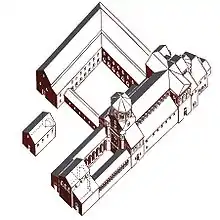Ottonian architecture
Ottonian architecture is an architectural style which evolved during the reign of Emperor Otto the Great. The style was found in Germany and lasted from the mid 10th century until the mid 11th century.[1][2]

Reconstruction of the abbey of Essen
Ottonian architecture draws its inspiration from Carolingian and Byzantine architecture.[1][2] Apart from some examples influenced by the octagonal Palatine Chapel at Aachen such as Ottmarsheim (11th century, Alsace) and the apse of the abbey of the Holy Trinity at Essen, religious architecture tends to diverge from the centralised plan. Inspiration though from the Roman basilica remains concurrent, and Ottonian architecture preserves the Carolingian double ended feature with apses at either end of the church.
Examples
- St Bartholomew's Church, Liège, Belgium.
- Church of St. Gertrude, Nivelles, Belgium (1046)
- Church of St. Michael, Hildesheim, Germany (1010–33)
- Abbey Church of Gernrode (960–965, apparently the first in Europe to have a tribune gallery)[1]
See also
- Ottonian art
- Ottonian Renaissance
- Category:Ottonian architecture
References
- Curl, James Stevens (2006). A dictionary of architecture and landscape architecture (2 ed.). Oxford [England]; New York: Oxford University Press. Entry: Ottonian Art. ISBN 9780191726484.
- "Ottonian". Art & Architecture Thesaurus. Getty Research. Retrieved 2 January 2019.
This article is issued from Wikipedia. The text is licensed under Creative Commons - Attribution - Sharealike. Additional terms may apply for the media files.

